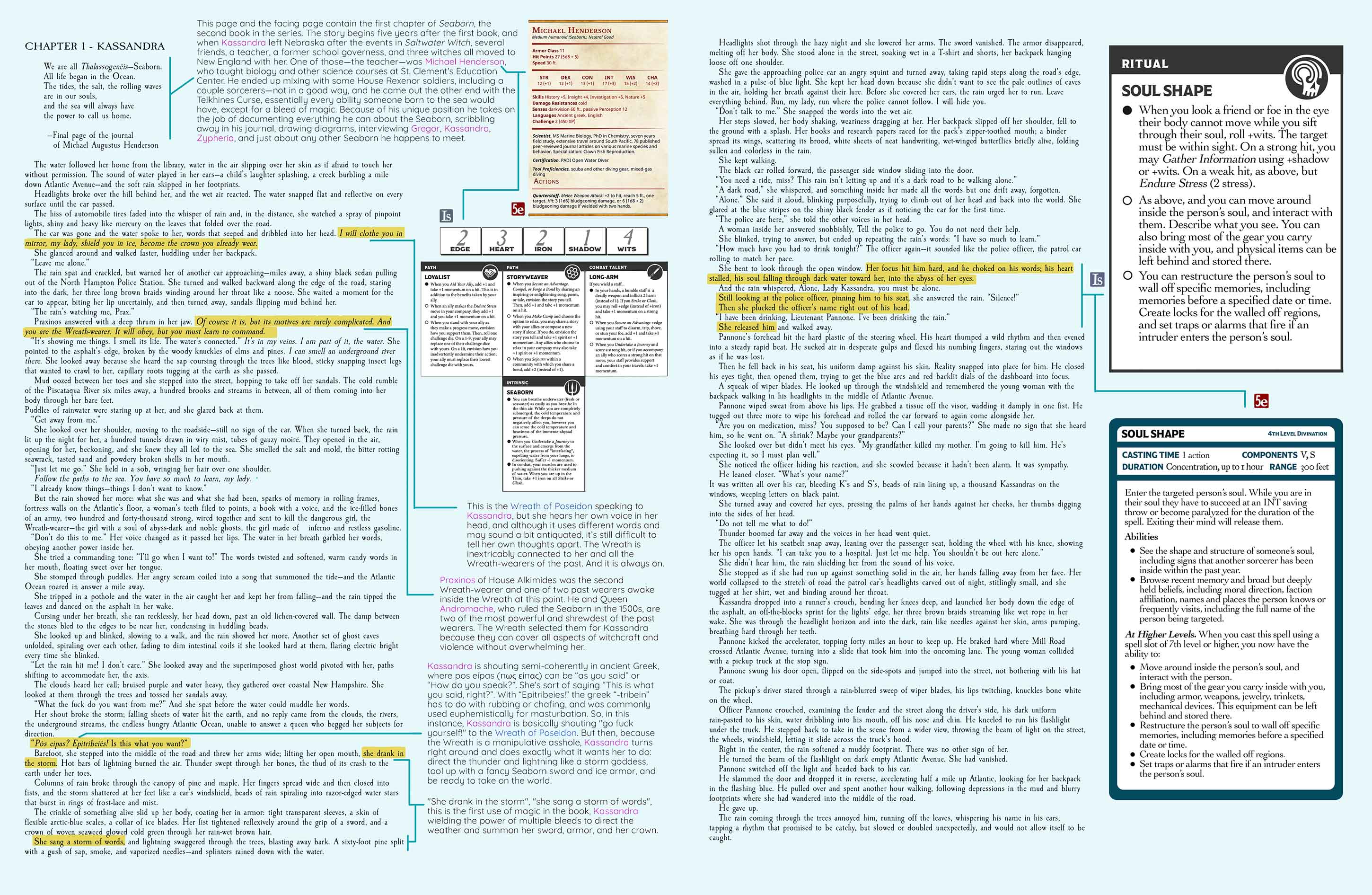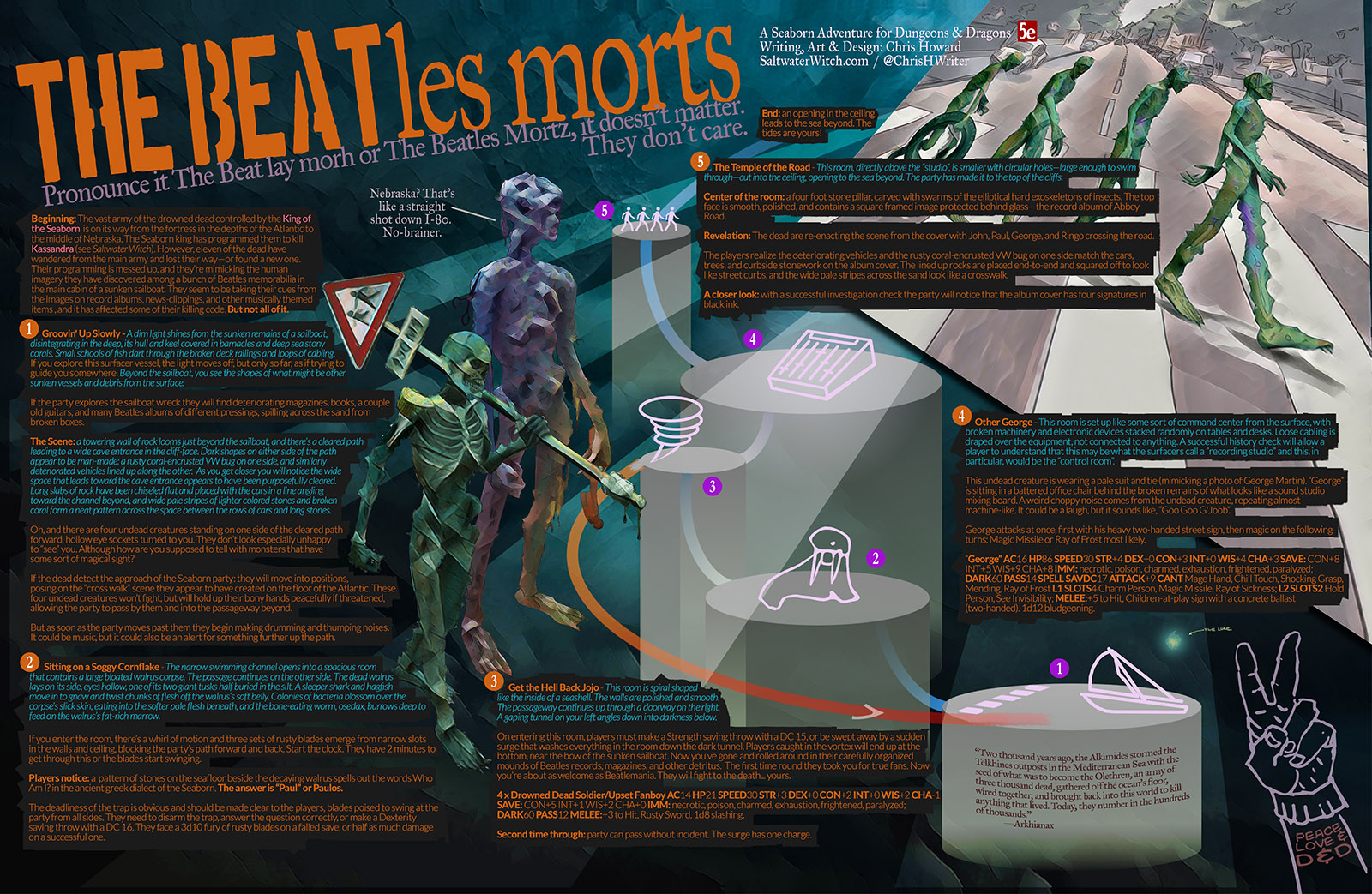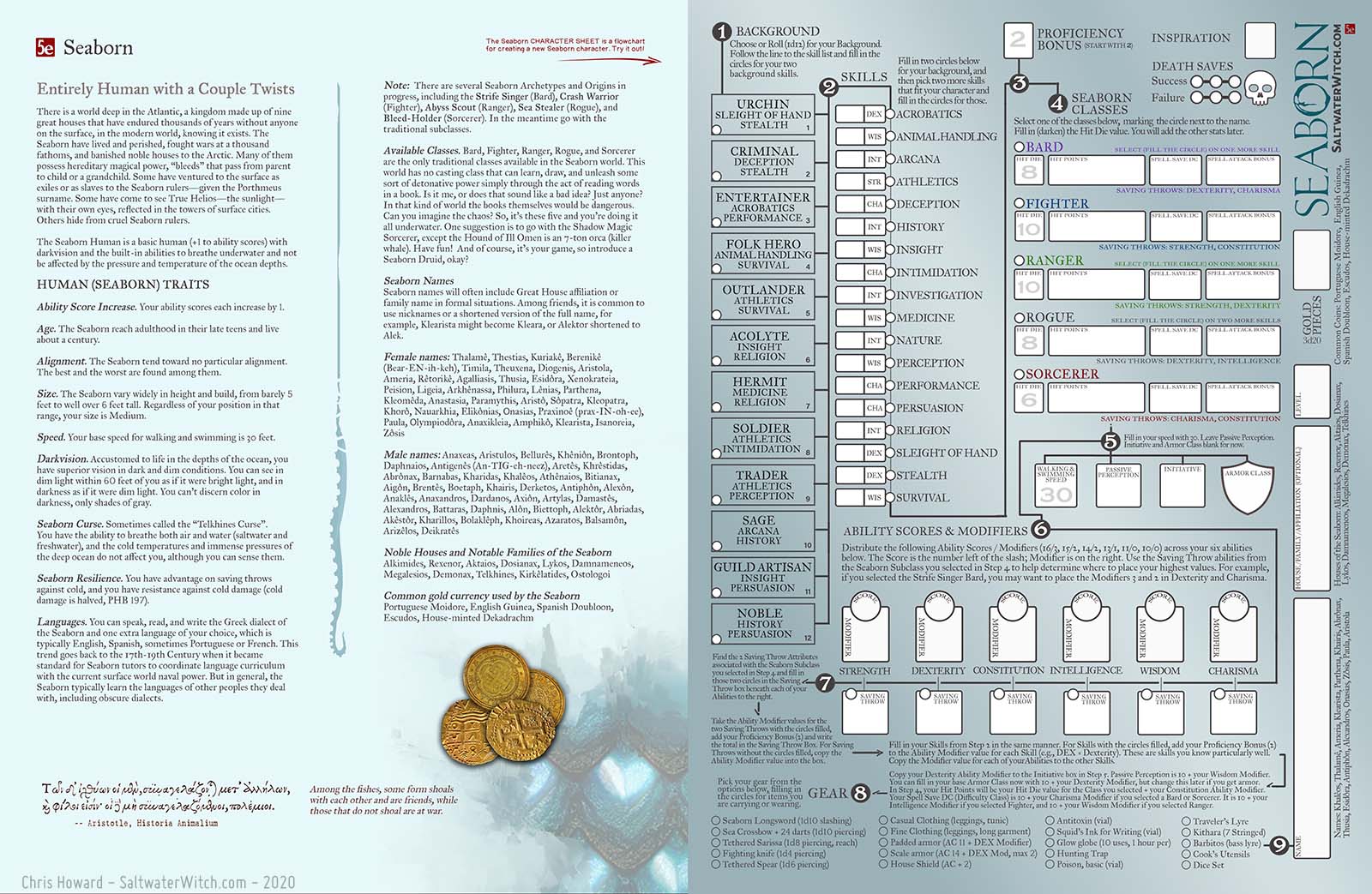Thoughts on Dungeons & Dragons and Apocalypse World
April 3, 2021
Continuing with my deconstruction (in a good way) of science fiction and fantasy roleplaying games like Apocalypse World and Dungeons & Dragons.
I'm stepping back from the mechanics and looking specifically at gameplay in this post. For the record, I think both systems are amazing, but there are foundational differences between the two rulesets that make it difficult to do any cross-adoption at the mechanical level. AW's Moves consolidate much of what D&D provides as Actions, Movement and general roleplaying, but they're inherently different animals—this includes throwing out ground-floor D&D rules such as the combat workflow being completely separate from normal the RP cycle—so, no need for initiative or turn-based rounds in most Apocalypse World-based games. The dice mechanics are also a big one, with Apocalypse World's 2d6 providing three clear outcomes—a miss, weak hit, and strong hit. D&D's d20 main mechanic provides success or failure, with small chances of critical failure or critical hit.
Okay, with all of that very important mechanical stuff out of the way, let's just focus on gameplay...
In my mind the differences between PbtA (Powered by the Apocalypse) games and D&D are mostly a matter of degrees of gameplay modes, and there can be significant overlap between them in gameplay style. I like to imagine a game panel with sliders, like on a sound mixing board, and two of the sliders drive story structure and story mode.
With story structure you have a completely open world on one side, with most of the world undeveloped and unprepared by the GM and players. The other end of the slider is what I might call "story world", which is a pretty well developed and playable world, with numerous named NPCs, dangers, and pre-built scenes that can be dropped into the path of characters--and all of this is usually part of a larger story in terms of a GM-proposed arc or fully developed published adventure.
The Story Structure slider looks like this:
Open world <--------------------> Story World
(Mostly Unknown) (Mostly known)
Storytelling mode is another slider on the game panel. On one side we have "Collaborative Storytelling", where the players and the GM share, on fairly equal terms, the world creation, establishing the tone of the game, character development, and in some cases complete story creation and management. On the other end of the slider we have the GM as the primary story driver, where most of the story direction—scenes, NPCs, the story details, what the characters will face in the tavern stable or in the next room, is managed by the GM. This is where the significant differences between PbtA games and D&D are obvious: Apocalypse World-based games typically run with the slider over to the collaborative end of the scale in "play to find out what happens" mode where a lot of the world, new encounters, and story development may come from the players during gameplay. And I'm imagining old-school dungeon crawls on the other end, with every step of the way mapped out, where play is focused on threat management, thoroughly understood goals and motivation, with dice determining most of the surprises in the game.
The Storytelling Mode slider looks like this:
Collaborative GM is the primary
Storytelling <-----------------> Story driver
Here's the thing. There are solid D&D games that go an hour without a dice roll. There are plenty of DMs who run whole D&D campaigns with the sliders pushed toward the left, with minimal prep, and no way to know where the players are going to take the story. I think the most common perception of D&D is of a very tactical game, where encounters are allegedly balanced and every adventuring party has some mix of fighter, spell-caster, cleric, and rogue—and where players have to roll dice to do anything. Of course, there are plenty of D&D games run in this manner, but I doubt there are enough to support this perception of typical game play, especially in this era of streamlined 5th Edition and streamed games, where we see entire parties of bards, or sessions with far more roleplaying than dice rolling, and with far less combat.
Constraint drives creativity
I think there are misconceptions about Dungeons & Dragons gameplay that lead many to pigeonhole D&D as a paint-by-numbers ruleset, while in reality it encourages and provides a wide variety of creative tools for customization and open world play, all within an established set of constraints—the constraints are mostly focused on common modes of play such as combat and magic. With D&D I can easily run an adventure in Waterdeep or 19th Century New York City, and player characters can cast Eldritch Blast in both. At the same time, I can play Apocalypse World in a dismal futuristic Columbus, Ohio, or in some unnamed Mad Max world, with a narrowly defined set of constraints on genre and tone (It's always going to be some sort of post-apocalyptic world). The two games focus on different mechanics and game foundations, but they both come with constraints that foster creative roleplaying.
At the end of the day these are personal choices. I definitely love reading Powered by the Apocalypse game rules and playbooks, and a lot of it has to do with my fascination with how different game designers have adapted PbtA rules, moves, and other mechanics to student life at Hogwarts, the Star Wars universe, or the trenches of World War I. In fact, I would encourage anyone thinking about upping their D&D or any roleplaying game to go to the source and read Apocalypse World, as well as any of the amazing work derived from AW. You may already be familiar with Ironsworn or Blades in the Dark, but pick up Masks, Urban Shadows, or the many other PbtA games to gain insight or ideas that you can apply when running your own games.
The apparent truth in "constraint drives creativity" always makes me think of Dungeons & Dragons, of tweaking the magic mechanics in new ways, or re-skinning the Druid class to fit into life in modern day Southern California. Apocalypse World makes me think of the Brian Eno quote about The Velvet Underground's first album--that it only sold 10,000 copies but everyone who bought one started a band.
Notes:
Creativity and Constraints: Exploring the Role of Constraints in the Creative Processes of Research and Development Teams, Brent D. Rosso, Vol 35, Issue 4, 2014, Organization Studies, https://doi.org/10.1177/0170840613517600
Great session postmortem from Runehammer (@HankrinFerinale) He's using the OSE—Old School Essentials ruleset. Some brilliant stuff here--"think in time lapse" is crazy good advice, and I've never heard this before.
The magic in Seaborn Chapter 1... and Mr. Henderson
November 1, 2020
This 2-page spread contains the complete chapter with highlighted magical events along with a defined NPC stat block for Michael Henderson for both Dungeons & Dragons 5e and Ironsworn. The spell/ritual Soul Shape is included for both as well.
Full size link:
https://www.dropbox.com/s/bs0p9f3cenrf3oq/SeabornChapter1-ChrisHoward_2PageSpread.jpg?dl=0

A one-page underwater adventure for Dungeons & Dragons
October 22, 2020
How about a one page Beatles-themed underwater D&D adventure featuring strays from a vast Army of the Drowned Dead? I think they're mostly here for the hip music, or some shadow of a feeling that music once gave them. Maybe they just need a little hand-holding.
Full-size link
https://www.dropbox.com/s/ucak3rlkurjrqrv/TheBEATlesMorts-DnDOneShot_ChrisHoward_20201012-14.jpg?dl=0

A Bit of Seaborn Lore - Magic
October 21, 2020
Seaborn Lore - Magic (according to Arkhianax)
In truth, we look like most people of the surface—we call them “surfacers” and sometimes “thinlings” because what they breathe is thin to those of us who dwell in the ocean’s depths. See, I can even write like one of their lettering machines. It should be simple for me to blend in.
—Arkhianax of the Family Khairinos, not affiliated with any of the great noble houses and their holdings, but of a minor family with distant ties to House Telkhines. We have our own powers and our own secrets.
Magic, the Three Worlds Interpretation
Humans live in the Dawnworld, mostly on its surface, although surfacers occasionally take to the air for short durations in special machinery designed for flight. Surfacer... that probably means you? Unless you’re a Rootworlder, or you’re Seaborn, in which case, well played. I barely noticed.
Magic is the technology of the Rootworld, and from this perspective, there are few limits to what you can research and know. Because it's all about the power that feeds you, power that you may or may not be able to control. It’s how you focus it. And you either have that or you don't. You are either hooked up to the Rootworld hub of all things perilously weird and monstrously bent, or you're not. And in this Dawnworld world, those who live in the depths of the sea, just happen to be.
Welcome.
Wait, where’s the last world in the three worlds interpretation? That’s the Winterdim, the volatile remains of a once beautiful place. Some time in the past million years a fury of Rootworlder furnace gods broke through the barriers between and seriously messed up the place. So, we don’t really talk about the Winterdim. It’s there, it has survived to some extent, with a ruler and a throne and all that, but it has troubles that no other known world has. Let’s leave that for another time and story.
Back to the source of magic.
Part of the function of this little work is to interpret this knowledge so that you can apply it to the rules for magic and ritual. The Seaborn world has no casting class that can learn, draw, and unleash some sort of detonative power simply through the act of reading words in a book. Is it me, or does that sound like a bad idea? Just anyone? In that kind of world the books themselves would be dangerous. Can you imagine? It’s perfectly fine to research spells jotted down in elaborately decorated books, ancient or otherwise. Who doesn’t have a library of such? Have at it. But you’re going to have that bleed of power from the Rootworld. That is the only true model for a Seaborn magic user.
Why start with Magic?
From my experience, fighting with cutting or piercing weapons is pretty much the same on all worlds, and dying is mostly the same. The tools change, the deadliness varies, but tactically, you will be near someone and will need to fight in a particular style, or far away, and you will use weapons and methods appropriate for harming someone from a distance. The primary difference with the Seaborn is our fight styles fit well with the three-dimensional world, our hydrospace. A surfacer calls it “fighting upside down” while one of the Seaborn just calls it fighting. Attacks from above, below, from any angle—all normal. In open water, the space is the same in every direction, and you can count on your adversary employing every direction as an advantage. I take it you’re planning to spend time beneath the waves? You will learn soon enough.
Let’s dive in.
Truths about the Seaborn World - 2 page spread
October 21, 2020
Truths about the Seaborn World 2-page spread in the Ironsworn style, with Kassandra in black and white, using the same categories plus one extra for the army of the drowned dead. They need their own.
Here's the Dropbox link to the full size page:
https://www.dropbox.com/s/mnsq9l9rxjbfkiz/SeabornRefGuideforTRPG_ChrisHoward_2020_Vol1_01_rev14-3.jpg?dl=0

Seaborn for Dungeons & Dragons 5e - Entirely Human with a Couple Twists
October 21, 2020
Want to play a Seaborn character in D&D 5e? The Seaborn CHARACTER SHEET is a flowchart that walks you through the creation process, step by step. I'd love to hear what you think of this!
Dropbox link to the full-size version:
https://www.dropbox.com/s/rga00i0j0w2d8fx/SeabornRefGuideforTRPG_ChrisHoward_2020_2PageSpread.jpg?dl=0
